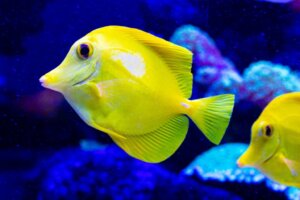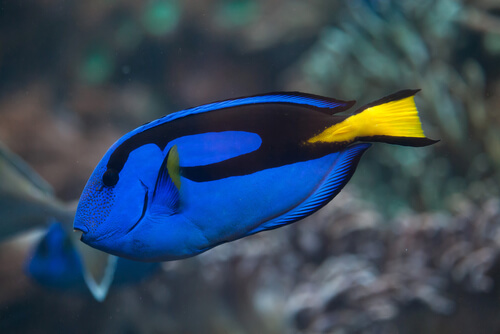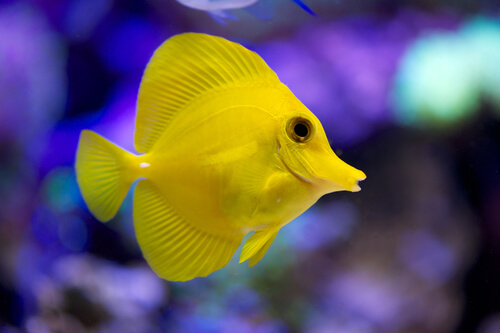The Surgeonfish: Habitat, Characteristics and Reproduction


Written and verified by the biologist Georgelin Espinoza Medina
The surgeonfish is one of the most well-known fish in the world. This is thanks to the Disney movie Finding Nemo and its sequel, with Dory as the main character, a blue surgeonfish. However, apart from being a character on screen, it’s a beautiful fish with a fascinating life on the reef.
Several species grouped together in the family Acanthuridae are known as surgeonfishes. They stand out for their striking, bright colors, and they’re often used in aquariums. In today’s article, we’ll tell you all about them, including their habitat, characteristics, reproduction, and other important aspects.
Habitat
These fish are distributed in the tropical and subtropical waters of the world (apart from the Mediterranean Sea). They inhabit coral reefs, with the greatest diversity found in the Pacific and Indian Oceans.
They do vary among the different types; for example, we can find some that prefer coastal areas with waves, sandy, or rocky bottoms, among others.

The surgeonfish: characteristics
Acanthurids have a peculiar appearance, a laterally flattened body, and small mouths. Generally, they’re small fish that don’t exceed 40 centimeters (16 inches) in length. However, some specimens can be larger. They have striking colors, which makes them very beautiful, and ideal for aquariums.
The distinctive aspects of this group are their spines or sharp plates, which they use to defend themselves from their enemies. In addition, they have quite large dorsal and anal fins, occupying a large part of the body length. The caudal fin has a peculiar truncated or crescent shape.
In some species, there’s sexual dimorphism, i.e. the males and females are different. In particular, in terms of size or certain aspects of their morphology.
A very popular species is the blue surgeonfish (Paracanthurus hepatus), with a very showy coloration, deep blue with black stripes and a yellow tail, as well as a dash of yellow on the edge of its pectoral fins.
Behavior
These fish are diurnal, and so at night, they seek shelter for protection. They show accelerated growth in the early stages of development. They also stand out for their longevity, as most specimens live for more than 30 years. During the reproductive season, it’s common to observe fights between males.
An interesting aspect to these fish is that they can form groups of varying sizes for feeding or reproduction (even with other species). However, there are taxa that don’t follow these habits and stay on their own.
Most surgeonfish are herbivores, but some of them consume small animals. Their diet is broad, and may include plankton, algae, and detritus. The teeth also have a certain variety. The mouth usually has a row of sharp teeth. They can migrate to feed, from shallow areas to other deeper areas.
Another curious fact is that some of these beautiful swimmers eat, along with algae, a large number of sediments that help their digestive process. They achieve this because they have thick-walled stomachs that can support the substances they consume.
Thanks to their feeding habits, the surgeonfish plays a very important role in the energy balance of coral reefs, transforming plant energy. They’re also involved in the transportation and recycling of nutrients during their migrations.
How do surgeonfish reproduce?
The reproduction of the members of this family is sexual, with egg production (oviparous) and external fertilization. They employ different strategies such as aggregations, harem formation, migrations, and also spawning on feeding grounds. Some species undergo sequential hermaphroditism, i.e. they can change sex during their lifetime.
The most frequent reproductive behavior is group spawning. Spawning may occur throughout the year with variable egg production. Some specimens show coloration changes during spawning and fights between males.
Parental care doesn’t exist in this group. Egg hatching occurs 2 to 3 days after spawning and fertilization. During their life cycle, they go through a pelagic larval stage (maintained in deep water). Sexual maturity usually occurs between 1 and 2 years of age and the length of the specimens is variable.
Conservation status

Acanthuridae are distributed in six genera, comprising 83 species in total. Although most of them aren’t in danger of extinction, one is a specimen cataloged as vulnerable, according to the International Union for Conservation of Nature (IUCN). This is Acanthurus chronixis, surgeonfish chronixis, threatened by intensive harvesting and fishing.
A latent threat to these species is the destruction of coral reefs in the world, due to multiple factors. These include temperature increases, harvesting, ocean acidification, pollution and disease.
Surgeons are captivating fish due to their appearance, coloration, and behavior. As you may have noticed, they play a role in the ecosystem, but their existence is threatened by intensive harvesting and reef destruction for which humans are largely responsible. However, you can also be part of the solution to achieve a better world for these beautiful swimmers.
The surgeonfish is one of the most well-known fish in the world. This is thanks to the Disney movie Finding Nemo and its sequel, with Dory as the main character, a blue surgeonfish. However, apart from being a character on screen, it’s a beautiful fish with a fascinating life on the reef.
Several species grouped together in the family Acanthuridae are known as surgeonfishes. They stand out for their striking, bright colors, and they’re often used in aquariums. In today’s article, we’ll tell you all about them, including their habitat, characteristics, reproduction, and other important aspects.
Habitat
These fish are distributed in the tropical and subtropical waters of the world (apart from the Mediterranean Sea). They inhabit coral reefs, with the greatest diversity found in the Pacific and Indian Oceans.
They do vary among the different types; for example, we can find some that prefer coastal areas with waves, sandy, or rocky bottoms, among others.

The surgeonfish: characteristics
Acanthurids have a peculiar appearance, a laterally flattened body, and small mouths. Generally, they’re small fish that don’t exceed 40 centimeters (16 inches) in length. However, some specimens can be larger. They have striking colors, which makes them very beautiful, and ideal for aquariums.
The distinctive aspects of this group are their spines or sharp plates, which they use to defend themselves from their enemies. In addition, they have quite large dorsal and anal fins, occupying a large part of the body length. The caudal fin has a peculiar truncated or crescent shape.
In some species, there’s sexual dimorphism, i.e. the males and females are different. In particular, in terms of size or certain aspects of their morphology.
A very popular species is the blue surgeonfish (Paracanthurus hepatus), with a very showy coloration, deep blue with black stripes and a yellow tail, as well as a dash of yellow on the edge of its pectoral fins.
Behavior
These fish are diurnal, and so at night, they seek shelter for protection. They show accelerated growth in the early stages of development. They also stand out for their longevity, as most specimens live for more than 30 years. During the reproductive season, it’s common to observe fights between males.
An interesting aspect to these fish is that they can form groups of varying sizes for feeding or reproduction (even with other species). However, there are taxa that don’t follow these habits and stay on their own.
Most surgeonfish are herbivores, but some of them consume small animals. Their diet is broad, and may include plankton, algae, and detritus. The teeth also have a certain variety. The mouth usually has a row of sharp teeth. They can migrate to feed, from shallow areas to other deeper areas.
Another curious fact is that some of these beautiful swimmers eat, along with algae, a large number of sediments that help their digestive process. They achieve this because they have thick-walled stomachs that can support the substances they consume.
Thanks to their feeding habits, the surgeonfish plays a very important role in the energy balance of coral reefs, transforming plant energy. They’re also involved in the transportation and recycling of nutrients during their migrations.
How do surgeonfish reproduce?
The reproduction of the members of this family is sexual, with egg production (oviparous) and external fertilization. They employ different strategies such as aggregations, harem formation, migrations, and also spawning on feeding grounds. Some species undergo sequential hermaphroditism, i.e. they can change sex during their lifetime.
The most frequent reproductive behavior is group spawning. Spawning may occur throughout the year with variable egg production. Some specimens show coloration changes during spawning and fights between males.
Parental care doesn’t exist in this group. Egg hatching occurs 2 to 3 days after spawning and fertilization. During their life cycle, they go through a pelagic larval stage (maintained in deep water). Sexual maturity usually occurs between 1 and 2 years of age and the length of the specimens is variable.
Conservation status

Acanthuridae are distributed in six genera, comprising 83 species in total. Although most of them aren’t in danger of extinction, one is a specimen cataloged as vulnerable, according to the International Union for Conservation of Nature (IUCN). This is Acanthurus chronixis, surgeonfish chronixis, threatened by intensive harvesting and fishing.
A latent threat to these species is the destruction of coral reefs in the world, due to multiple factors. These include temperature increases, harvesting, ocean acidification, pollution and disease.
Surgeons are captivating fish due to their appearance, coloration, and behavior. As you may have noticed, they play a role in the ecosystem, but their existence is threatened by intensive harvesting and reef destruction for which humans are largely responsible. However, you can also be part of the solution to achieve a better world for these beautiful swimmers.
All cited sources were thoroughly reviewed by our team to ensure their quality, reliability, currency, and validity. The bibliography of this article was considered reliable and of academic or scientific accuracy.
- Animal Diversity Web (ADW). Acanthuridae. Recuperado el 17 de abril de 2022 de https://animaldiversity.org/accounts/Acanthuridae/
- Díaz-Ruiz, S., Alva-Basurto, C., & Aguirre-León, A. (2007). Distribución y abundancia de las especies de peces “cirujano” (Acanthuridae) en arrecifes coralinos del caribe mexicano. ContactoS, 63, 52-58.
- Duarte, S., & Acero, A. (1988). Hábitos alimentarios de los peces del género Acanthurus (Perciformes: Acanthuridae) en la región de Santa Marta (Caribe colombiano). Revista de Biología Tropical, 36 (2B), 399-405.
- Myers, R., Choat, J.H., Abesamis, R., Clements, K.D., McIlwain, J., Nanola, C., Rocha, L.A., Russell, B. & Stockwell, B. (2012). Acanthurus chronixis. The IUCN Red List of Threatened Species 2012: e.T177966A1505213.
- Vilanova, R., Gómez, M., Vieira, F., Vasconcelos, P. (2018). Reproductive biology of Acanthurus coeruleus (Bloch & Schneider, 1801) (Perciformes: Acanthuridae) in the north coast of the State of Pernambuco, Brazil. Pan-American Journal of Aquatic Sciences, 13(1), 25-35.
This text is provided for informational purposes only and does not replace consultation with a professional. If in doubt, consult your specialist.








